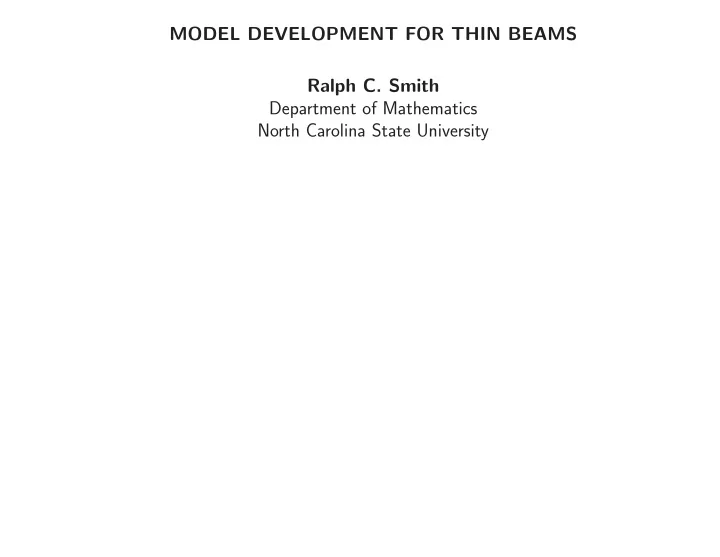

MODEL DEVELOPMENT FOR THIN BEAMS Ralph C. Smith Department of Mathematics North Carolina State University
APPLICATIONS PVDF Polyimide (b) (a) (c) (d) Note: (a) Thin beam with surface-mounted PZT patches employed as a prototype for vibration control. (b) Polymer unimorph comprised of PVDF and polyimide presently considered for pressure sensing and flow control. (c) Curved THUNDER transducer whose width is small compared with the length. d) Electrostrictive MEMs actuator employed as a high speed shutter.
FORCE AND MOMENT BALANCING PVDF Polyimide w w f f Q( ( ) Q (x) ) (x) x+ ∆ x M x + ∆ x M + x x x + ∆ x x x ∆ Force Balance: � x +∆ x � x +∆ x ρ∂ 2 w � � f ( t, s ) − γ∂w ∂t 2 ( t, s ) ds = Q ( t, x + ∆ x ) − Q ( t, x ) + ∂t ( t, s ) ds x x • Divide by ∆ x and take ∆ x → 0 to obtain ρ∂ 2 w ∂t 2 + γ∂w ∂t = ∂Q ∂x + f
FORCE AND MOMENT BALANCING PVDF Polyimide w w f f ( Q (x) Q( ) (x) ) x+ ∆ x M x + ∆ x M x x + ∆ x x x + x ∆ Force Balance: � x +∆ x � x +∆ x ρ∂ 2 w � � f ( t, s ) − γ∂w ∂t 2 ( t, s ) ds = Q ( t, x + ∆ x ) − Q ( t, x ) + ∂t ( t, s ) ds x x • Divide by ∆ x and take ∆ x → 0 to obtain ρ∂ 2 w ∂t 2 + γ∂w ∂t = ∂Q ∂x + f Moment Balance: � x +∆ x M ( t, x + ∆ x ) − M ( t, x ) − Q ( t, x + ∆ x )∆ x + f ( t, s )( s − x ) dx = 0 x • Note: Limit yields Q = ∂M ∂x ρ∂ 2 w ∂t − ∂ 2 M ∂t 2 + γ∂w • Beam Model: ∂x 2 = f
MOMENT RELATION Heuristic: M ( t, x ) = − α∂ 2 y ∂x 2 α = Y h 3 b 12
MOMENT RELATION Heuristic: M ( t, x ) = − α∂ 2 y ∂x 2 α = Y h 3 b 12 More Generally: M ( t, x ) = − Y I ( x ) ∂ 2 y ∂x 2 − cI ( x ) ∂ 3 y ∂x 2 ∂t
BEAM MODEL: STRONG FORMULATION Strong Formulation: ρ∂ 2 w ∂t − ∂ 2 M ∂t 2 + γ∂w ∂x 2 = f ( t, x ) w ( t, 0) = ∂w ∂x ( t, 0) = 0 M ( t, ℓ ) = ∂M ∂x ( t, ℓ ) = 0 ∂w w (0 , x ) = w 0 ( x ) , ∂t (0 , x ) = w 1 ( x ) where M ( t, x ) = − Y I ( x ) ∂ 2 y ∂x 2 − cI ( x ) ∂ 3 y ∂x 2 ∂t
BEAM MODEL: WEAK FORMULATION Weak Formulation: � ℓ � ℓ � ℓ � ℓ ρ∂ 2 w M d 2 φ γ∂w ∂t 2 φdx + ∂t φdx − dx 2 dx = fφdx 0 0 0 0 or � ℓ � ℓ � ℓ ρ∂ 2 w Y I∂ 2 w d 2 φ γ∂w ∂t 2 φ dx + ∂t φ dx + dx 2 dx ∂x 2 0 0 0 � ℓ � ℓ cI ∂ 3 w d 2 φ + dx 2 dx = fφ dx ∂x 2 ∂t 0 0 for all appropriate test functions φ .
FINITE DIMENSIONAL APPROXIMATION Basis and Approximate Solution: 4 • Basis: { φ j ( x ) } 1 x j−2 x j−1 x j x j+1 x j+2 N +1 � • Approximate Solution: w N ( t, x ) = w j ( t ) φ j ( x ) j =1 • Second-order Matrix System M ¨ w + Q ˙ w + K w = f where w = [ w 1 ( t ) , . . . , w N +1 ( t )] T and � ℓ [ M ] ij = ρφ i φ j dx 0 � ℓ γφ i φ j + cIφ ′′ i φ ′′ � � [ Q ] ij = dx j 0 � ℓ Y Iφ ′′ i φ ′′ [ K ] ij = j dx 0
BEAM APPROXIMATION: CONSTANT PARAMETERS Time Domain: model response 60 measured data 40 displacement ( µ m) 20 0 −20 −40 −60 0 0.5 1 1.5 2 2.5 3 3.5 time (s) Frequency Domain: −8 7 x 10 model response measured data 6 5 4 power 3 2 1 0 0 20 40 60 80 100 frequency (Hz)
BEAM APPROXIMATION: PIECEWISE-CONSTANT PARAMETERS Time Domain: model response 60 measured data 40 displacement ( µ m) 20 0 −20 −40 −60 0 0.5 1 1.5 2 2.5 3 3.5 time (s) Frequency Domain: −8 7 x 10 model response measured data 6 5 4 power 3 2 1 0 0 20 40 60 80 100 frequency (Hz)
Recommend
More recommend